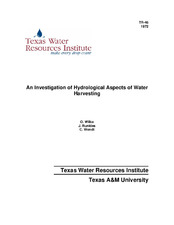| dc.description.abstract | Water harvesting is a potential source of water for arid and semiarid lands. The objectives of this study were to determine combinations of land surface treatments and land forming which result in efficient but inexpensive water harvesting catchments and to determine the optimum shape of catchments.
In laboratory studies with inexpensive materials, crude oils exhibited the best sealing properties. However, by six months after application, 750 gal per ac of crude oil had no apparent effect on runoff from field plots.
Water harvesting catchments constructed by grading the soil to form V-shaped valleys and then compacting the surface yielded runoff equal to 31 to 43 percent of all precipitation After rains, sand blown from such catchments may damage tender downwind vegetation. Some water erosion occurred, but, after two years, the basic shape and the performance of the catchments had not been damaged by erosion. Chemical weed control is recommended.
Hydrographs were successfully modeled by the kinematic wave method. Hydrologic parameters were estimated by a univariate procedure. The initial infiltration of the soil surface had the greatest effect on the amount of runoff. Thus, additional or repeated compaction may be the best practice for increasing runoff from such surfaces. Surface roughness had little effect on the amount of runoff.
The results of hydrograph simulation indicate that catchments should be as narrow as can be constructed easily with conventional equipment. A catchment width of 16 ft may be about optimum. Catchment side slopes should be between 0.1 and 0.20 Generally, catchments should be no more than 1/8 mi long. With these side slopes and lengths, channel slopes can be as little as 0.002 without causing excessive loss of runoff. To prevent erosion, channel slopes should not exceed 0.005. Catchment surfaces should be wetted by rain or by sprinkling before rolling. Surfaces should be rolled with a rubber-tired roller for 1.5 to 3 hrs per ac. Drop structures should be installed at elevation changes to prevent erosion.
The cost of constructing graded catchments should be $55 per ac or less. The cost of harvested water is expected to be about $8.00 per ac-in. Efficiently-utilized natural runoff should be less expensive water. | en |


